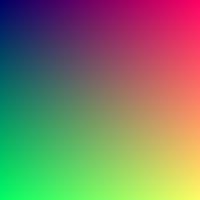This post is continuation of Vector Operations in Go.
Foreword
Before moving forward with implementing a camera model, it would be good to have some sort of debugging tool. When writing a ray tracer, that tool is a rendered image.
Go has a built-in image package, that allows to easily create images, and save them as files on the disk.
Design
The scene will be represented by a struct. Internally it will store the width and height of the desired image, as well as a pointer to an instance of image.RGBA.
type Scene struct {
Width, Height int
Img *image.RGBA
}
Initialization
In order to initialize the scene, we need to initialize the image.RGBA with the given dimensions. In Go this is done by creating an image.Rect struct and passing it to the image.NewRGBA function.
The whole code required to initialize the scene will be done in the NewScene function. The function should accept two integers as arguments, that represent the width and height of the image:
func TestNewSceneReturnsANewScene(t *testing.T) {
scene := NewScene(4, 4)
rect := image.Rect(0, 0, 4, 4)
assert.Equal(t, 4, scene.Width, "sets width of the scene")
assert.Equal(t, 4, scene.Height, "sets height of the scene")
assert.True(t, assert.ObjectsAreEqualValues(rect, scene.Img.Bounds()),
"creates an image.RGBA with proper bounds")
}
func NewScene(width int, height int) *Scene {
return &Scene{
Width: width,
Height: height,
Img: image.NewRGBA(image.Rect(0, 0, width, height)),
}
}
The assert library exposes some nifty helper functions, like ObjectsAreEqualValues which does a deep equality check of an object’s values.
Test helpers
In order to test the following functions, I needed to write two helper functions to generate a new image.RGBA and fill the image with a random color:
func generateImage(w, h int, pixelColor color.RGBA) *image.RGBA {
img := image.NewRGBA(image.Rect(0, 0, 4, 4))
for x := 0; x < 4; x++ {
for y := 0; y < 4; y++ {
img.Set(x, y, pixelColor)
}
}
return img
}
func randomColor() color.RGBA {
rand := rand.New(rand.NewSource(time.Now().Unix()))
return color.RGBA{uint8(rand.Intn(255)), uint8(rand.Intn(255)), uint8(rand.Intn(255)), 255}
}
I use these helpers to generate expected image.RGBA objects for ObjectsAreEqualValues.
Traversing the image
For each pixel of the image, I want to set a specific color. This can be done simply enough by a double for loop, but we can expose a convenience function on Scene, called EachPixel. Go allows us to specify functions as arguments for other functions. We will leverage this fact by requiring a single argument in EachPixel — a function with the following signature func(int, int) color.RGBA. The two int values are the x and y coordinates of the image (which will be used later on for calculating a pixel in the image plane). The full implementation of the EachPixel function looks like this:
func (s *Scene) EachPixel(colorFunction func(int, int) color.RGBA) {
for x := 0; x < s.Width; x++ {
for y := 0; y < s.Height; y++ {
s.setPixel(x, y, colorFunction(x, y))
}
}
}
func TestSceneEachPixelSetsEachPixelToTheProvidedFunctionReturn(t *testing.T) {
scene := NewScene(4, 4)
c := randomColor()
scene.EachPixel(func(x, y int) color.RGBA { return c })
img := generateImage(4, 4, c)
assert.True(t, assert.ObjectsAreEqualValues(img, scene.Img),
"sets every pixel of the image to the provided values")
}
The setPixel function is just an adapter for Go’s built-in image.RGBA.Set.
Saving the image
Finally I want to save the image to a PNG file. As one might suspect, Go provides such a function in the image/png package, called png.Encode. Again, I’ve built an adapter for this function, that takes a filename, under which it should save the image.
func (s *Scene) Save(filename string) {
f, err := os.Create(filename)
if err != nil {
panic(err)
}
defer f.Close()
png.Encode(f, s.Img)
}
func TestSceneSavePanicsWhenFileCannotBePersisted(t *testing.T) {
scene := NewScene(4, 4)
c := randomColor()
scene.EachPixel(func(x, y int) color.RGBA { return c })
assert.Panics(t, func() {
scene.Save("/etc/temp.png")
}, "panics when the file cannot be persisted")
}
Several interesting things happen in this code:
os.Create(filename)— the function has multiple returns; this is a common pattern for [error handling in Go](//blog.golang.org/error-handling-and-go:- f — the file descriptor
- err — any error that may have happened during the file creation, for example insufficient privileges
defer f.Close()— the defer keyword delays execution of the passed code until the surrounding function returns; in this case, the file won’t close until the Save function finishes executing it’s commandsassert.Panics— another nice feature of the assert library, instead of taking expected/actual values of the assertion, it takes a function that is supposed to panic (raise an exception), if the function does panic it passes the test; this is similar to RSpec’sexpect { subject }.to raise_error StandardError.
Putting it all together
Here’s a simple main function that fills the image with values based on the current pixel:
package main
import (
"fmt"
"image/color"
"time"
"github.com/szeliga/goray/engine"
)
func main() {
var width = 200
var height = 200
scene := engine.NewScene(width, height)
scene.EachPixel(func(x, y int) color.RGBA {
return color.RGBA{
uint8(x * 255 / width),
uint8(y * 255 / height),
100,
255,
}
})
scene.Save(fmt.Sprintf("./renders/%d.png", time.Now().Unix()))
}
This code produces the following image:

That’s all regarding creating and saving images in Go. Next up, a basic camera model, stay tuned.

Response to “Creating Images in Go”